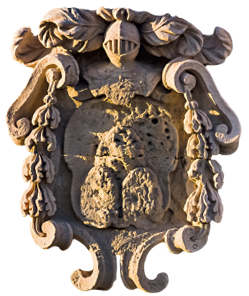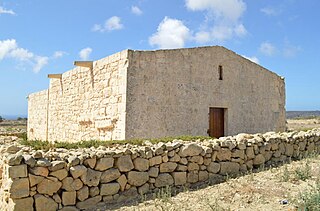
Comino is a small island of the Maltese archipelago between the islands of Malta and Gozo in the Mediterranean Sea, measuring 3.5 square kilometres (1.4 sq mi) in area. Named after the cumin seed, the island has a permanent population of only two residents and is part of the municipality of Għajnsielem, in southeastern Gozo, from where one priest and one policeman commute. The island is a bird sanctuary and nature reserve.

Victoria, also known among the native Maltese as Rabat or by its title Città Victoria, is an administrative unit of Malta, and the main town on Gozo. Victoria has a total population of 6,901, and by population, is the largest locality in Gozo.

Għajnsielem, meaning "Peaceful Spring", is a municipality on the southeastern coast of the island of Gozo in Malta, including the entire island of Comino. It has a population of 3,200 residents, and is the first Gozitan village that greets the visitor on leaving Mġarr Harbour towards the Gozitan heartland. Its name originated from the water spring, around which in 1700, Grandmaster Perellos built an arcade containing public wash basins and fresh water spouts. Attractions include Lourdes Chapel with its sharp steeple and underlying niche of Our Lady of Lourdes, Fort Chambray and the towering of Ghajnsielem Parish Church.

Qala is an administrative unit of Malta, on the island of Gozo, with a population of 1,929 as of September 2019. Nearby is Ħondoq ir-Rummien, a coastline with salt pans and caves.

Saint Agatha's Tower, also known as the Red Tower, Mellieħa Tower or Fort Saint Agatha, is a large bastioned watchtower in Mellieħa, Malta. It was built between 1647 and 1649, as the sixth of the Lascaris towers. The tower's design is completely different from the rest of the Lascaris towers, but it is similar to the earlier Wignacourt towers. St. Agatha's Tower was the last large-bastioned tower to be built in Malta.

The Diocese of Gozo is a Latin diocese of the Catholic Church in Malta, and the only suffragan in the ecclesiastical province of the Metropolitan Archdiocese of Malta, together covering the insular state.

St. George's Basilica or the Basilica and Collegiate Parish Church of Saint George, also simply known as San Ġorġ in Maltese, is a historic Baroque church situated in the middle of Gozo, the second largest island in the Maltese archipelago, and is surrounded by a maze of old narrow streets and alleys. Today's basilica was built between 1672 and 1678.
The Wignacourt towers are a series of large coastal watchtowers built in Malta by the Order of Saint John between 1610 and 1620. A total of six towers of this type were constructed, four of which survive.

In the small Mediterranean island nation of Malta, the predominant religion is Roman Catholicism.

Saint Mary's Tower, also known as the Comino Tower, is a large bastioned watchtower on the island of Comino in Malta. It was built in 1618, the fifth of six Wignacourt towers. The tower was used by the Armed Forces of Malta until 2002, and it is now in the hands of Din l-Art Ħelwa.
Vittorio Cassar, born Gio Vittorio Cassar, was a Maltese architect and military engineer. The son of the renowned architect Girolamo Cassar, he was admitted as a knight within the Order of St. John in 1587. He became the Order's resident engineer in the early 17th century, and he directed the upgrading of the Cittadella of Gozo between 1600 and 1603.

The Chapel of the Annunciation is a Medieval Roman Catholic church located in Ħal-Millieri, limits of Żurrieq, Malta.

Wirt Għawdex is a non-governmental organisation founded in 1981 with the aims of fostering the knowledge of Gozitan heritage amongst all levels of society and to strive to safeguard the natural, archaeological, historical and anthropological patrimony of the Maltese islands of Gozo and Comino.
Saint Mary's Redoubt, also known as Migart Redoubt, was a redoubt on the island of Comino in Malta. It was built by the Order of Saint John in 1716 or 1761 as one of a series of coastal fortifications around the Maltese Islands.

The St Cecilia Chapel is a former Roman Catholic chapel in the limits of Xewkija, Gozo, Malta, dedicated to Saint Cecilia. It was built around 1540, but it was deconsecrated in 1644, being converted into an ancillary building for the nearby Santa Cecilia Tower.

The Chapel of St Matthew, popularly known as San Mattew Iż-Żgħir, literally meaning Saint Matthew the smaller, is a small medieval chapel located beside a larger church with the same name in an area known as il-Maqluba in Qrendi, Malta. The use of the word the smaller is used that one would not confuse it with the larger St Matthew's church.

St Catherine's Chapel officially the Church of St Catherine and St Peter is an 18th-century Roman Catholic church located in Mqabba, Malta.

The Parish Church of the Assumption of the Blessed Virgin Mary into Heaven is a Roman Catholic parish church in Żebbuġ, Gozo, Malta, dedicated to the Assumption of Mary. The present building was built between 1690 and 1726 on the site of an earlier church, and it was enlarged between 1938 and 1942. The church's interior was extensively decorated using locally-sourced travertine from cave deposits in the late 20th century.

The Chapel of Saint Mary of Ħal Tmin is a Roman Catholic 16th century chapel located in the outskirts of the village of Żejtun in Malta. Today the church remains in very good condition, with the teaching of catechism classes and other forms of religious activities and meetings organised in it. The chapel building is placed on the list of National Inventory of the Cultural Property of the Maltese Islands.

















